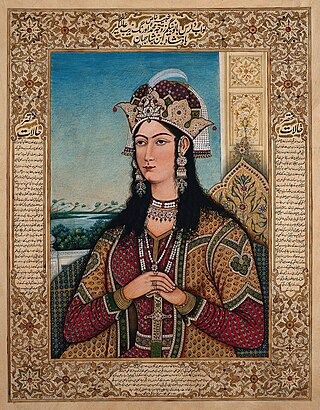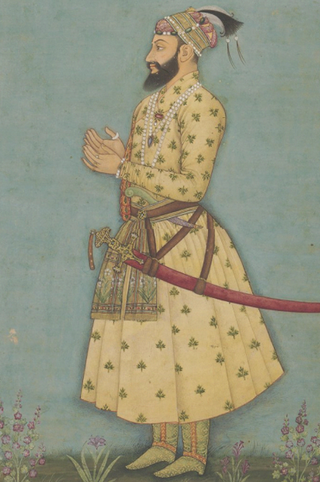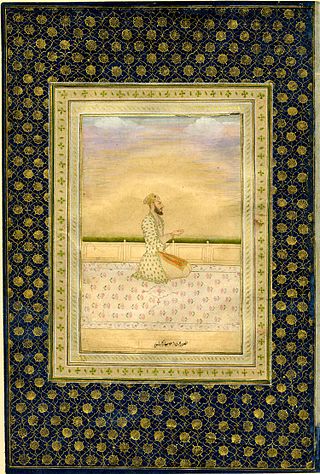Related Research Articles

Dara Shikoh, also transliterated as Dara Shukoh, was the eldest son and heir-apparent of the Mughal emperor Shah Jahan. Dara was designated with the title Padshahzada-i-Buzurg Martaba and was favoured as a successor by his father and his elder sister, Princess Jahanara Begum. He had been given the title of 'Shah-e-Buland Iqbal' by Shah Jahan. In the war of succession which ensued after Shah Jahan's illness in 1657, Dara was defeated by his younger brother Prince Muhiuddin. He was executed in 1659 on Aurangzeb's orders in a bitter struggle for the imperial throne.

Mirza Abu'l Fayaz Qutb-ud-Din Mohammad Azam, commonly known as Azam Shah, was briefly the seventh Mughal emperor from 14 March to 20 June 1707. He was the third son of the sixth Mughal emperor Aurangzeb and his chief consort Dilras Banu Begum.

Sir Jadunath Sarkar, was a prominent Indian historian and a specialist on the Mughal dynasty.

Zeb-un-Nissa was a Mughal princess and the eldest child of Emperor Aurangzeb and his chief consort, Dilras Banu Begum. She was also a poet, who wrote under the pseudonym of "Makhfi".

Muhammad Saleh Kamboh Lahori was a noted Punjabi Muslim calligraphist and official biographer of Emperor Shah Jahan and the teacher of Mughal Emperor Aurangzeb. Though a widely read person, little is known of the life of Muhammad Saleh Kamboh other than the works he composed. He was son of Mir Abdu-lla, Mushkin Kalam, whose title shows him to also have been a fine writer. He is believed to be younger brother of Inayat-Allah Kamboh and worked as a Shahi Dewan (Minister) with the governor of Lahore. He held the title of Sipahsalar.
The Ramoshi are an Indian aboriginal community found largely in Maharashtra, Madhya Pradesh, and Karnataka. They are classified as a Scheduled Tribe by the government of India.

Dilras Banu Begum was the first wife and chief consort of Emperor Aurangzeb, the sixth Mughal emperor. She is also known by her posthumous title, Rabia-ud-Durrani. The Bibi Ka Maqbara in Aurangabad, which bears a striking resemblance to the Taj Mahal, was commissioned by her husband to act as her final resting place.

Jahanzeb Banu Begum, popularly known as Jani Begum, was a Mughal princess and the chief consort of Muhammad Azam Shah, the heir-apparent to Emperor Aurangzeb, who briefly became Mughal emperor in 1707.
Zubdat-un-Nissa Begum was a Mughal princess, the third daughter of Emperor Aurangzeb and his wife Dilras Banu Begum.

Rahmat-un-Nissa, better known by her title Nawab Bai, was a secondary wife of the Mughal emperor Aurangzeb. She gave birth to Aurangzeb's first two sons, including Bahadur Shah I, who became Mughal emperor in 1707. Nawab Bai was unpopular at the Mughal court and lost her husband's favour quite early on in her life while the misconduct of her sons, Muhammad Sultan and Muhammad Muazzam, embittered her latter life. She died in 1691 in Delhi after long years of separation from her husband and children.
Udaipuri Mahal was one of the concubines of the Mughal emperor Aurangzeb.
Aurangabadi Mahal was a consort (concubine) of the Mughal emperor Aurangzeb.

Mirza Muhammad Sultan was the eldest son of Mughal emperor Aurangzeb and his second wife Nawab Bai. His younger brother Muazzam later became Emperor as Bahadur Shah I in 1707.

Muhammad Bidar Bakht was a Mughal prince. His father, Muhammad Azam Shah, briefly reigned as Mughal emperor in 1707. Bidar was noted for being a gallant, skilful and successful general and was regarded as the most able Mughal prince of his time. He was the favourite grandson of Emperor Aurangzeb.
Shahar Banu Begum was Empress consort of the Mughal Empire from 14 March 1707 to 8 June 1707 as the third wife of Emperor Muhammad Azam Shah. She is popularly known by the titles Padishah Bibi and Padshah Begum.
Zainabadi Mahal was a concubine of Mughal emperor Aurangzeb.

The Tomb of Aurangzeb is located in Khuldabad, Aurangabad district, Maharashtra, India. In notable contrast to other Mughal tombs, which are large monuments of Mughal architecture, including the Taj Mahal, at his own direction Aurangzeb is buried in an unmarked grave at the complex of the dargah or shrine of Sheikh Zainuddin.
Khulasat-ut-Tawarikh is a Persian language chronicle written by Sujan Rai in the Mughal Empire of present-day India. It deals with the history of Hindustan, and it also contains details about the contemporary Mughal Empire. Sujan Rai completed the book in 1695 CE, during the reign of Aurangzeb. An insertion about Aurangzeb's death was later added to the original copy by a transcriber.
Nur-un-Nissa Begum was the first wife and chief consort of Mughal emperor Bahadur Shah I.
References
- ↑ Sreedharan 2004, p. 445.
- ↑ A Comprehensive History of India: Comprehensive history of medieval India By B.N. Puri, M.N. Das
- ↑ Davies, C. Collin (1949). "Review of Maāsir-i-'Ālamgīrī of Sāqī Must'ad Khān; The Travels of the Abbé Carré in India and the Near East, 1672 to 1674". Journal of the Royal Asiatic Society of Great Britain and Ireland (1): 104–106. ISSN 0035-869X. JSTOR 25222314.